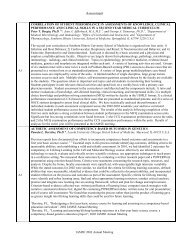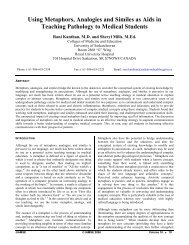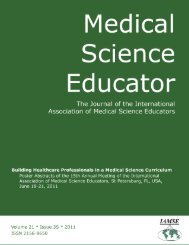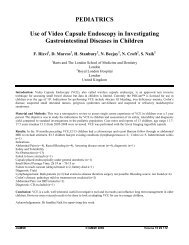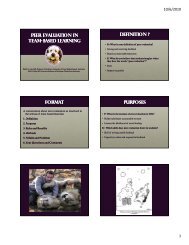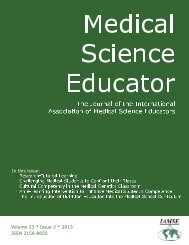Click here to view complete journal in pdf-format - IAMSE
Click here to view complete journal in pdf-format - IAMSE
Click here to view complete journal in pdf-format - IAMSE
Create successful ePaper yourself
Turn your PDF publications into a flip-book with our unique Google optimized e-Paper software.
RESULTS<br />
The TBL results, exam<strong>in</strong>ation scores, and student<br />
evaluations of the active-learn<strong>in</strong>g session and<br />
demonstration are discussed.<br />
CONCLUSIONS<br />
These exercises tie basic science and nutrition <strong>to</strong> a<br />
cl<strong>in</strong>ical picture <strong>in</strong> the context of a patient's day <strong>to</strong><br />
day diet. By help<strong>in</strong>g students understand nutrition<br />
and cook<strong>in</strong>g of common foods, they better<br />
understand the challenges their patients face <strong>to</strong><br />
ma<strong>in</strong>ta<strong>in</strong> a healthy lifestyle. Our long term goal is <strong>to</strong><br />
re<strong>in</strong>force biochemistry, metabolism and nutrition<br />
through <strong>in</strong>novative active learn<strong>in</strong>g, demonstrations,<br />
and practical community-based application.<br />
TBL/PBL Abstract ID: 221<br />
USE OF PROBLEM BASED LEARNING (PBL)<br />
TO TEACH THE ACGME CORE<br />
COMPETENCIES OF SYSTEMS AND<br />
IMPROVEMENT AT ROSS UNIVERSITY<br />
SCHOOL OF MEDICINE<br />
Valarie Thomas 1 , Diana Callender 1 , Sean Gnecco 1<br />
T<strong>in</strong>a Foster 2 Nancy Selfridege 1 and Greg Ogr<strong>in</strong>c 2<br />
1 Department of Integrated Medic<strong>in</strong>e, Ross<br />
University School of Medic<strong>in</strong>e, Picard Dom<strong>in</strong>ica<br />
2 Dartmouth Medical School, Hanover, NH, USA<br />
PURPOSE<br />
Ross University School of Medic<strong>in</strong>e has<br />
<strong>in</strong>corporated the ACGME competencies <strong>in</strong><strong>to</strong> its<br />
modular curriculum so that students can <strong>in</strong>tegrate<br />
them with the basic sciences.<br />
METHODS<br />
In their PBL course, first year students learn the<br />
importance of us<strong>in</strong>g evidence-based medic<strong>in</strong>e<br />
(EBM); a model <strong>to</strong> apply EBM <strong>in</strong> practice; and how<br />
<strong>to</strong> select search terms and access and appraise the<br />
resources found. In semester one, students work<br />
through a cardiovascular case which <strong>in</strong>cludes a<br />
delay <strong>in</strong> treatment result<strong>in</strong>g <strong>in</strong> residual heart<br />
damage. As a group, students develop a cause and<br />
effect diagram <strong>to</strong> identify system level problems that<br />
contributed <strong>to</strong> the patient outcome. In semester<br />
two, students focus on the differences between<br />
measurement for research, judgment, and<br />
improvement us<strong>in</strong>g a case which <strong>in</strong>cludes a central<br />
l<strong>in</strong>e <strong>in</strong>fection. Us<strong>in</strong>g run charts, students identify<br />
special and common cause variation <strong>to</strong> assess the<br />
impact of the <strong>in</strong>terventions used <strong>to</strong> reduce central<br />
l<strong>in</strong>e <strong>in</strong>fections. Knowledge and skills for these PBL<br />
sessions are ga<strong>in</strong>ed from core curriculum lectures,<br />
read<strong>in</strong>g assignments from the assigned text and<br />
learn<strong>in</strong>g objectives developed dur<strong>in</strong>g PBL sessions<br />
and core curriculum lectures.<br />
RESULTS<br />
Students aptly apply the techniques of cause and<br />
effect diagrams and measurement for variation<br />
effectively <strong>in</strong> PBL. Overall performance on MCQ<br />
exam questions related <strong>to</strong> these <strong>to</strong>pics is 55%.<br />
CONCLUSIONS<br />
PBL, <strong>in</strong> conjunction with lectures and read<strong>in</strong>gs, is<br />
an effective way of teach<strong>in</strong>g early medical students<br />
about systems and quality improvement, although<br />
students still f<strong>in</strong>d it challeng<strong>in</strong>g <strong>to</strong> apply the<br />
concepts <strong>in</strong> MCQs.<br />
TBL/PBL Abstract ID: 222<br />
M1 STUDENT PERCEIVED FEATURES<br />
ASSOCIATED WITH HIGH QUALITY TBL<br />
PREPARATORY MATERIALS<br />
Pamela Holt MET, Beth Krippendorf PhD, Diane<br />
Brown MS, Joan Bed<strong>in</strong>ghaus MD, Michael Oliver<br />
PhD, James Sebastian MD, Karen Marcdante MD,<br />
USA<br />
PURPOSE<br />
A core team-based learn<strong>in</strong>g (TBL) component is the<br />
prepara<strong>to</strong>ry material (PM) provided <strong>to</strong> students <strong>in</strong><br />
advance of session attendance. While TBL literature<br />
emphasizes PM’s importance, limited <strong>in</strong><strong>format</strong>ion is<br />
available regard<strong>in</strong>g student perceived features<br />
associated with high quality. The project sought <strong>to</strong><br />
identify student perceived attributes associated with<br />
high quality PMs.<br />
METHODS<br />
Four teams, 7 precl<strong>in</strong>ical students/team, provided<br />
daily evaluations of TBL sessions and materials over<br />
a 1-year period us<strong>in</strong>g a comb<strong>in</strong>ation of Likert scales<br />
and narrative (e.g., What worked well/didn’t work<br />
well?). Narrative data was analyzed us<strong>in</strong>g standard<br />
qualitative analysis methods <strong>to</strong> identify common<br />
themes associated with high quality PMs. Results<br />
were then vetted with experienced TBL <strong>in</strong>struc<strong>to</strong>rs<br />
who confirmed f<strong>in</strong>d<strong>in</strong>gs.<br />
RESULTS<br />
Four major themes emerged from the analysis: PMs<br />
aligned <strong>to</strong> objectives; importance associated with<br />
quantity/volume; strategic redundancy (multiple<br />
PMs on same <strong>to</strong>pic); structure/<strong>format</strong>. Specifically<br />
PMs must explicitly align <strong>to</strong> session objectives as<br />
students’ actively use objectives <strong>to</strong> guide their study<br />
and <strong>in</strong>fer importance by quantity of materials. PMs<br />
(read<strong>in</strong>gs, study guides) must be clear, concise and<br />
at appropriate level for comprehensive level<br />
learn<strong>in</strong>g with<strong>in</strong> available study time.<br />
Medical Science Educa<strong>to</strong>r © <strong>IAMSE</strong> 2012 Volume 22(4S) 324



